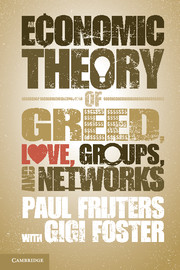Book contents
6 - Theoretical appendix: Formal models and extensions
Published online by Cambridge University Press: 05 May 2013
Summary
This chapter contains several mathematical models that formalize aspects of the story presented in this book. The first model gives suggestions about how one can include both love and greed in simple models of choice. The second model shows how one can model the interrelations between groups, group power, violence, and social norms. The third model focuses on how the concepts of love and greed can be used in models of many agents to generate the emergence of central authorities. The fourth and final model provides ideas about how one can envisage the relationships between networks, technology, labor time, and business cycles.
The first two models, whose central focus is on love and groups, were generated recently with this book in mind. The third and fourth models were generated years ago for specific projects, and should be seen as stepping stones in the development of the ideas in this book.
Model 1: Love and greed at the individual level
The object of this model is to formalize how one might conceptualize love in the context of simple choice behavior. Since the object is to capture the basic mechanism, the model abstracts from many of the possibilities covered in the text, such as uncertainty or mistakes. To capture the dynamic-investment aspect of love, whereby investments into love during one stage have repercussions in a later stage, the model includes two time periods. An individual in the first time period has the option of investing in love, which may yield a utility return, and the “cost” of that investment is not only a direct transfer to the love object but also that the lover's identity in the second time period will change.
Information
- Type
- Chapter
- Information
- An Economic Theory of Greed, Love, Groups, and Networks , pp. 349 - 396Publisher: Cambridge University PressPrint publication year: 2013
